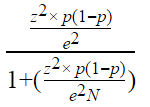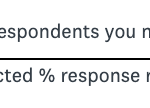SurveyMonkey
Calculating the Number of Respondents You Need
The number of respondents you need depends on your survey goals and how confident you want to be in your results. The more confident you want to be, the less of a margin of error you should accept.
To calculate the number of respondents you need (known as your sample size), use our sample size calculator.
Definitions
To calculate your sample size, you'll need to know the following information:
- Population Size
- Margin of Error
- Confidence Level
- Percentage Value
Calculating Sample Size
Calculate the number of respondents you need in seconds using our sample size calculator. If you’d like to do the sample size calculation by hand, use the following formula:

Statistic | Description |
| N | Population Size |
| e | Margin of Error (as a decimal) |
| z | Confidence Level (as a z-score) |
| p | Percentage Value (as a decimal) |
Suggested Sample Sizes
Below is a table with suggested population sizes by margin of error at a 95% confidence level. We used the above formula to calculate the suggested sample sizes. In some cases, we rounded the sample sizes up to the nearest 5 or 10. For a more exact calculation, use our sample size calculator.
| Population Size | Sample Size per Margin of Error | Sample Size per Margin of Error | Sample Size per Margin of Error |
| ±3% | ±5% | ±10% | |
| 500 | 345 | 220 | 80 |
| 1,000 | 525 | 285 | 90 |
| 3,000 | 810 | 350 | 100 |
| 5,000 | 910 | 370 | 100 |
| 10,000 | 1,000 | 385 | 100 |
| 100,000+ | 1,100 | 400 | 100 |
Example Sample Size
You're sending a survey with a Yes or No question asking if parents of children at your school are in favor of an extended school day.
The total number of parents (your population size) is 10,000 and you're comfortable with a ±10% margin of error. Using the table above, you can see you'll need at least 100 people to take your survey.
70% of the 100 parents surveyed answered that they are in favor of an extended school day. This means you can assume that if all 10,000 parents answered the survey, between 60% to 80% of people would be in favor of an extended school day.
How many people should I ask to take my survey?
Your response rate may affect the number of people you send your survey to. The higher the response rate, the fewer people you need to ask to take your survey.
For example, if you need 100 respondents and you expect 25% of the people invited to take your survey will actually respond, then you need to invite 400 people to take your survey.
To calculate the number of people you need to invite to take your survey based on your expected response rate, use the following equation:

Respondents needed
Take the number of people you need to answer your survey
÷ Response rate
Divide by the expected response rate (use 25 for 25%, if you use .25 skip step 3)
x 100
Then multiply by 100 (to account for the using a percentage versus a decimal in step 2)